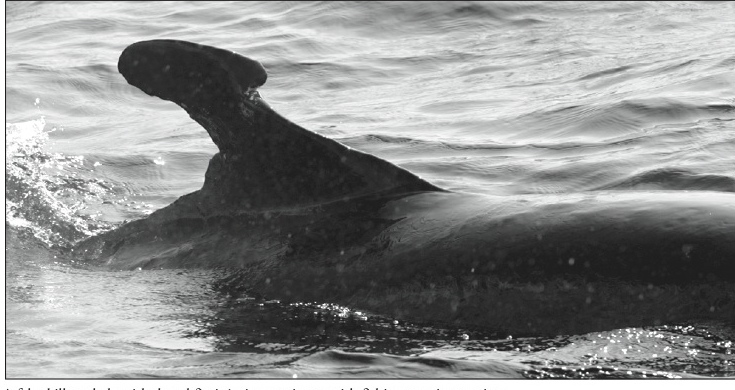When estimating the number of false killer whales that interact with the longline fishery, scientists and resource managers do not try to guess the sex of any individual caught.
But a recently published study of dorsal fin disfigurements concludes that fisheries interactions with false killer whales around Hawai`i probably involve females more often than males – which in turn suggests gear interactions have a disproportionate impact on population dynamics, over and above that which would be expected if both sexes were represented equally.
The article, “False killer whales and fisheries interactions in Hawaiian waters: Evidence for sex bias and variation among populations and social groups,” was published late last year in the journal Marine Mammal Science. Lead author was Robin Baird of the Cascadia Research Collective, who has done much of the research on false killer whales in and around Hawai`i. Other authors included three from the National Marine Fisheries Service’s science centers in Honolulu and La Jolla; three more from Cascadia; and two from non-governmental organizations.
Prompting their work were two events, they write. First, in October 2013, the National Marine Fisheries Service announced its intention to prepare a recovery plan for the Main Hawaiian Islands (MHI) false killer whale population. “An assessment of dorsal fin injuries as an indicator of fisheries interactions may have relevance for recovery planning,” they write. The second event was the discovery that a false killer whale from the MHI population found stranded at South Point, on the Big Island, had five fish hooks in his stomach, at least three of which were not of a type used in the longline fishery.
The researchers first reviewed a catalog of false killer whales photographed between 2000 and 2013 around Hawai`i. Almost 300 individual animals could be identified from good-quality photographs. Of those, 19 had disfigured dorsal fins, with scarring suggesting a possible interaction with fishing gear. Four individuals were from the pelagic population, two from the Northwestern Hawaiian Islands insular population, and 13 from the Main Hawaiian Islands insular population.
Photos of those 19 individuals were then scored by seven experts, who ranked them on a scale of 1 to 3, with a score on the low end meaning the injury was not likely to have resulted from an interaction. A score of 3 meant it was consistent with such an interaction.
Thirteen of the 19 received an average score higher than 2.5 – one from the pelagic population, and 12 from the MHI population. Eight individuals were scored higher than 2.7, and all were from the MHI population. None from the NWHI group scored this high. The MHI individuals accounted for 7.5 percent of the total number of MHI false killer whales identifiable through good-quality photographs.
The researchers were further able to identify those 12 MHI individuals down to the clusters they associated with. Half of them came from Cluster 3 – a rate that was more than three times that for Cluster 1.
Sex was known for six of the 12 MHI false killer whales, while it was inferred for a seventh – and all of them were female. One of the females had injuries from two different events, based on photographs over time.
The authors suggest several possible explanations for the apparent sex bias: “Females may be involved in depredation [preying on hooked fish] at higher rates than males, reflecting either the higher energy needs of females during lactation and/or the importance of prey sharing among females… Conversely, it is possible that male false killer whale interactions with fisheries are more likely to be lethal. Males are, on average, larger and heavier than females … and thus might have a greater likelihood of breaking lines when hooked, and trailing gear may impede feeding or locomotion.”
In any event, “if females are interacting with fisheries at a higher rate, then fisheries-related mortality may have a disproportionate influence on population dynamics, influencing the rate of growth, and thus potential recovery, of the population to a greater extent than if fisheries-related mortality rates were equal for both sexes or were biased towards males,” the authors go on to say.
“In addition, if a female involved in a fatal fisheries interaction has a dependent calf, it is probable the calf will not survive, thus effectively resulting in two deaths.”
The articles conclude with a recommendation for management. Recovery planning for the MHI population, designated as endangered under the Endangered Species Act, “should account for the social structure of the population and the potential for impacts from human activities acting disproportionately on certain social groups,” they write. “Furthermore, our results, combined with the evidence from the stranded individual with a variety of hooks in the stomach, suggest there is a need to broaden the scope of the Take Reduction Plan [for false killer whales], which currently focuses only on the longline fisheries, to include nearshore fisheries.” (The Take Reduction Plan, developed under the Marine Mammal Protection Act, limits the number of MHI false killer whales that can be harmed in a given year by interactions with the Hawai`i-based longline fishery.)
On March 31, the Western Pacific Fishery Management Council’s Scientific and Statistical Committee subcommittee on false killer whales was to meet in Honolulu to “review and discuss the revisions of false killer whale stock boundaries and bycatch proration method for incidental take in the Hawai`i longline fishery.”
— Patricia Tummons


Leave a Reply